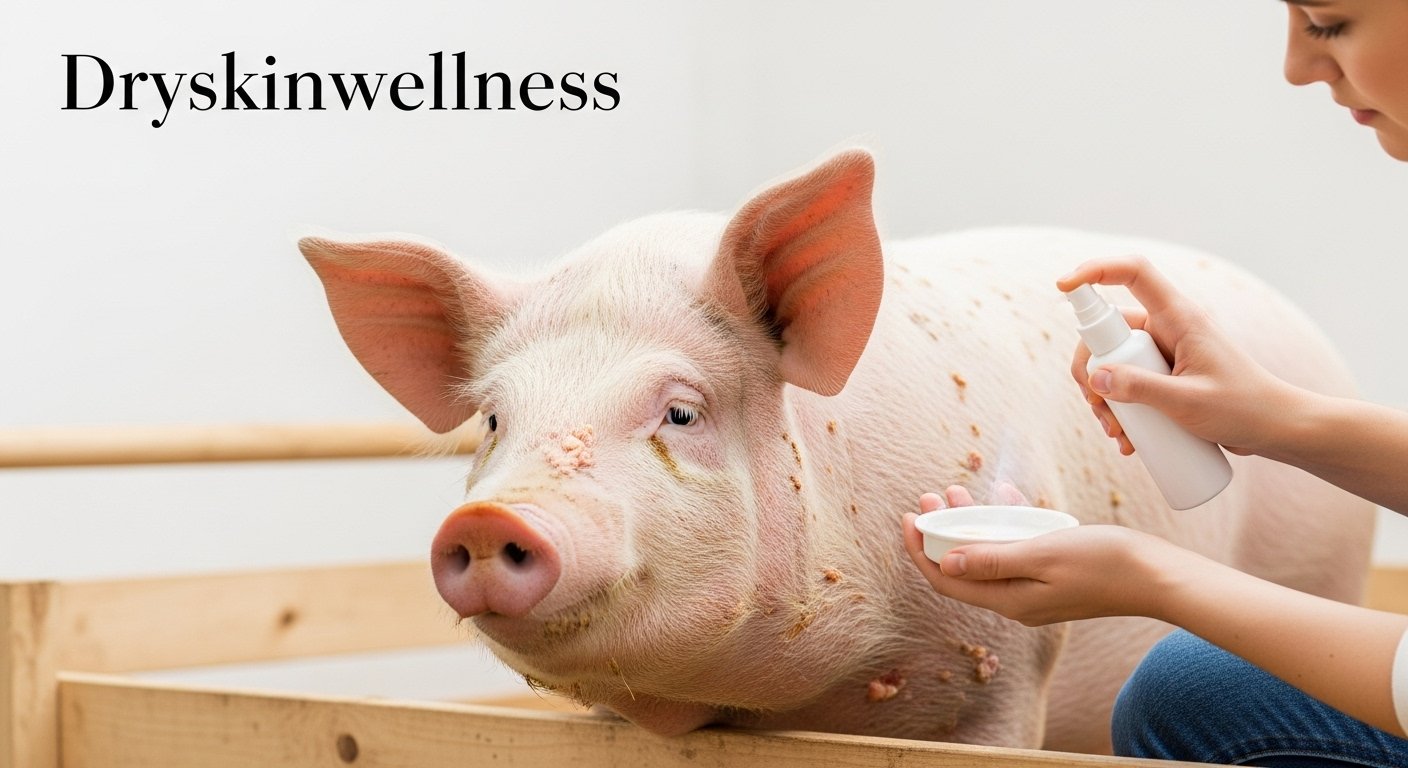how do you treat dry skin on pigs | Best Guide
Don’t let dry skin hog the spotlight – treat it right with these pig-tastic tips!
To treat dry skin on pigs, start by ensuring they have a healthy and balanced diet. Bathing pigs with a gentle shampoo and applying a moisturising lotion or oil can also help. Additionally, providing them with a comfortable and clean environment can prevent dry skin from occurring in the first place. Consult a veterinarian for severe cases.
Based on my experience, treating dry skin on pigs is essential to maintaining their overall health and comfort. I have found that a healthy and balanced diet is crucial in preventing dry skin from occurring in the first place.
Additionally, bathing pigs with a gentle shampoo and applying moisturising lotion or oil has been effective in treating dry skin.
However, severe cases should be addressed by a veterinarian. With the right care, your pig’s skin can be healthy and silky smooth.
In this article, I’ll reveal the top tips for treating dry skin on pigs and keeping them happy and healthy!
So Let’s Get Started!
Understand Causes of Dry Skin on Pigs
Dry skin on pigs can be caused by various factors. Here are some of the most common causes:
Poor Nutrition
A lack of essential nutrients, especially fatty acids, can lead to dry skin in pigs. It’s important to provide your pigs with a balanced diet to prevent dryness.
Environmental Factors
Pigs that are kept in dry or dusty environments may develop dry skin due to a lack of humidity. Providing them with a clean and comfortable living space can help prevent this.
Over Bathing
Frequent or excessive bathing can strip the natural oils from a pig’s skin, leading to dryness. It’s recommended to limit bathing to once a month or less.
Parasites
External parasites like mange and lice can irritate a pig’s skin and cause dryness. It’s important to keep your pigs free of parasites through regular cleaning and treatment.
Health Issues:
Certain health conditions like hypothyroidism, allergies, and skin infections can also cause dry skin in pigs. A veterinarian can help diagnose and treat these conditions.
Understanding the causes of dry skin on pigs can help prevent and treat the condition, leading to healthier and happier pigs.
Signs and Symptoms of Dry Skin on Pigs
Dry skin on pigs can manifest in a number of ways. Here are the details of each sign and symptom.
Dry, flaky skin
Dry skin causes the skin to lose its natural oils, leading to flakiness and roughness. The skin may appear dull, scaly, and may feel rough to the touch.
Hair loss
When pigs have dry skin, they may scratch and rub against objects in an attempt to relieve the itchiness, which can lead to hair loss. Hair loss may occur in patches or all over the body.
Scratching and itching
Pig skin may feel itchy and uncomfortable when it’s dry, causing the pig to scratch or rub against surfaces in an attempt to relieve the irritation.
Crusty or scabby skin
In severe cases, the skin may become excessively dry, leading to the formation of crusty or scaly patches. This can be uncomfortable for the pig and can lead to further skin damage.
Redness and inflammation
Dry skin can lead to irritation and inflammation, which causes the skin to become red and sensitive. The affected skin may be warm to the touch and tender.
If you observe any of these signs and symptoms in your pig, it’s important to take action to prevent the dry skin from getting worse.
This may include dietary changes, environmental modifications, and skin treatments such as moisturisers or shampoos. In severe cases, consult a veterinarian.
Prevention how do you treat dry skin on pigs
Preventing dry skin in pigs is important for their overall health and well-being. Here are some prevention methods:
Proper nutrition and hydration
Providing pigs with a balanced diet rich in essential nutrients, especially fatty acids, can help maintain healthy skin. Access to clean water is also crucial for hydration.
Clean and dry environment
Pigs should be kept in a clean and dry environment to prevent excessive dryness. Make sure their living space is free from dust and dirt, and provide a comfortable and appropriate temperature.
Regular grooming
Regular grooming helps to remove dirt, dander, and dead skin cells, which can contribute to dryness. Brushing and washing your pig occasionally can help keep their skin healthy.
Parasite prevention
External parasites like mange and lice can irritate a pig’s skin and contribute to dryness. Use appropriate treatments to keep parasites under control.
Early detection and treatment of skin diseases
Regularly checking your pig’s skin for any signs of skin diseases like dermatitis, mange or ringworm is crucial. Early detection and treatment of such diseases can prevent dry skin and further complications.
By following these preventative measures, you can help ensure your pig’s skin remains healthy and hydrated, preventing dry skin and other skin-related issues.
Home Remedies for Treating Dry Skin on Pigs
If you notice dry skin on your pig, there are a few home remedies you can try before consulting a veterinarian. Here are some steps you can take to treat dry skin on pigs at home:
Apply coconut oil
Coconut oil has natural moisturising properties and can help soothe and hydrate dry skin. Apply a small amount of coconut oil to your pig’s skin and massage gently. Do this once a day until you see an improvement.
Oatmeal bath
An oatmeal bath can help soothe dry and itchy skin. Mix ground oatmeal with warm water to form a paste, then add it to a tub of warm water. Soak your pig in the tub for 10-15 minutes, then rinse with clean water and dry thoroughly.
Aloe vera
Aloe vera is known for its skin-soothing properties. Apply a small amount of aloe vera gel directly to the affected area and massage gently. Repeat once a day until you see an improvement.
Apple cider vinegar
Apple cider vinegar has antimicrobial properties that can help prevent infections and soothe dry skin. Dilute apple cider vinegar with water in a 1:1 ratio, then apply it to your pig’s skin using a spray bottle or cloth. Repeat once a day until you see an improvement.
Increase humidity
Dry air can contribute to dry skin, so increasing the humidity in your pig’s living area can help. Use a humidifier or place a pan of water near the enclosure to increase the moisture in the air.
Remember to monitor your pig’s skin for any signs of improvement or worsening. If the dry skin persists or worsens, or if you notice other concerning symptoms, consult a veterinarian for further advice and treatment.
Tips for preventing the recurrence of dry skin on pigs
Preventing the recurrence of dry skin on pigs is crucial for their overall health and well-being. Here are some tips to help prevent the recurrence of dry skin:
Regular grooming
Regular grooming helps to remove dirt, dander, and dead skin cells, which can contribute to dryness. Brushing and washing your pig occasionally can help keep their skin healthy and prevent the recurrence of dry skin.
Proper nutrition and hydration
Providing pigs with a balanced diet rich in essential nutrients, especially fatty acids, can help maintain healthy skin. Access to clean water is also crucial for hydration and the prevention of dry skin.
Avoid harsh soaps and shampoos
Harsh soaps and shampoos can strip the skin of its natural oils, leading to dryness. Use gentle and mild products specifically formulated for pigs.
Maintain a clean and dry environment
Pigs should be kept in a clean and dry environment to prevent excessive dryness. Regularly cleaning their living space can help prevent the recurrence of dry skin.
Address underlying health issues
Skin issues can be a symptom of underlying health issues such as allergies or hormonal imbalances. Addressing these underlying issues can help prevent the recurrence of dry skin.
By following these tips, you can help prevent the recurrence of dry skin on your pig and keep their skin healthy and hydrated. If you notice any signs of dry skin or other skin-related issues, consult a veterinarian for further advice and treatment.
Conclusion
In conclusion, dry skin on pigs can be a common and uncomfortable issue, but it can be prevented and treated. Proper nutrition, hydration, and grooming can go a long way in maintaining healthy skin.
If you notice signs of dry skin on your pig, there are several home remedies you can try before seeking veterinary help. However, if the condition persists or worsens, it is important to consult a veterinarian for further advice and treatment.
By taking preventative measures and addressing any underlying health issues, you can help keep your pig’s skin healthy and prevent the recurrence of dry skin.
FAQs
What Can I Put On Dry Pig Skin?
For dry pig skin, you can apply natural oils such as coconut oil, olive oil, or jojoba oil. These oils are rich in fatty acids and can help moisturise the skin. You can also try using aloe vera gel or petroleum jelly to help soothe and protect the skin.
Why Is My Pig’s Skin Dry?
Dry skin on pigs can be caused by several factors such as poor nutrition, dehydration, harsh soaps or shampoos, dirty living conditions, and underlying health issues. It is important to address the underlying cause to prevent the recurrence of dry skin.
How Do You Treat Dry Pig Skin At Home?
There are several home remedies you can try to treat dry pig skin at home. You can provide your pig with a healthy and balanced diet, ensure they have access to clean water, and maintain a clean and dry living environment. You can also try applying natural oils, aloe vera gel, or petroleum jelly to moisturise and soothe the skin. Regular grooming and parasite prevention can also help prevent dry skin.
Is Coconut Oil Good For Pig’s Skin?
Yes, coconut oil can be good for a pig’s skin. It is a natural oil that is rich in fatty acids and can help moisturise and soothe dry skin. However, it is important to use it in moderation and to consult with a veterinarian before using any new product on your pig’s skin.




